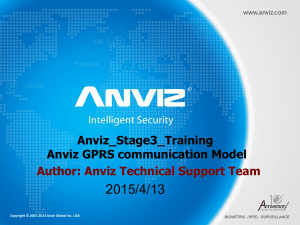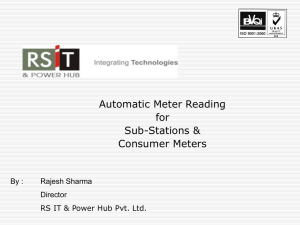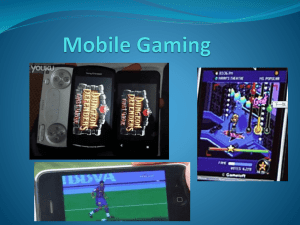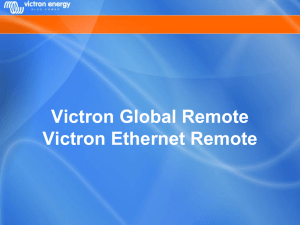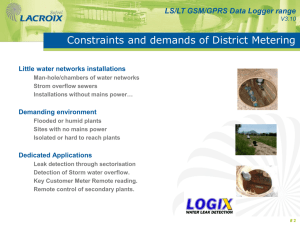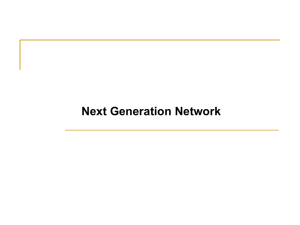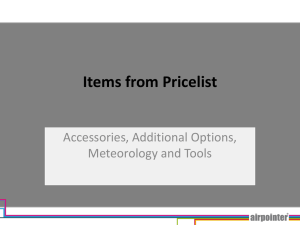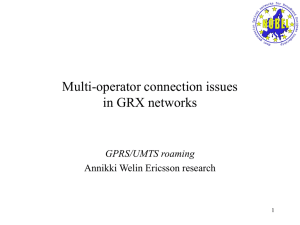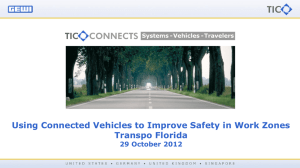gprs - RF Wireless systems and standards
advertisement
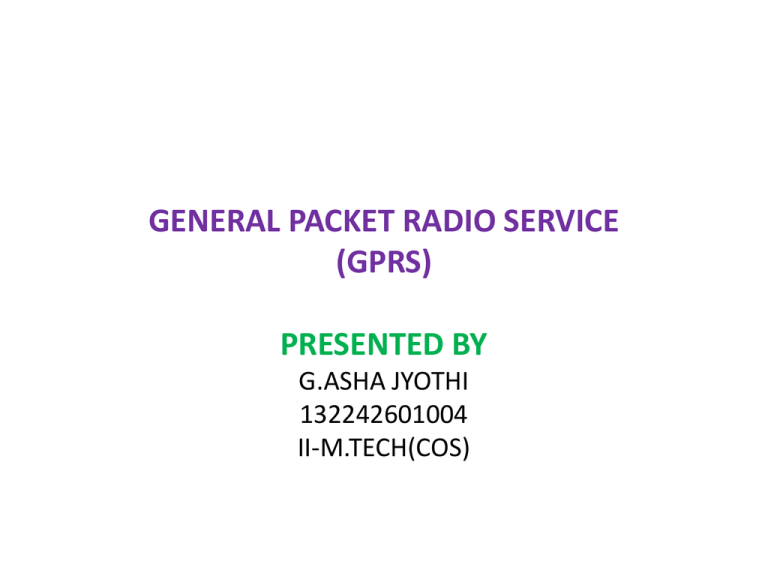
GENERAL PACKET RADIO SERVICE (GPRS) PRESENTED BY G.ASHA JYOTHI 132242601004 II-M.TECH(COS) CONTENTS 1.Introduction to GPRS 1.a) What is GPRS??? 1.b)Services offered 1.c)GPRS characteristics 1.d)Applications 2.GPRS Architecture 2.a)GPRS Network Nodes 3.GPRS Interfaces 4.GPRS Mobile Types 5.How to make money with GPRS??? 6.User’s Benefits of GPRS 7.Advantages 8.Drawbacks References 1.Introduction to GPRS 1.a)What is GPRS??? General Packet Radio Service (GPRS) is a packet oriented mobile data service on the 2G and 3G cellular communication’s systems global system for mobile communications (GSM). GPRS standardization was initiated by ETSI/SMG in 1994. GPRS reuses the existing GSM infrastructure to provide end-to-end packet switched services. It is now maintained by 3rd Generation Partnership Project(3GPP). It is a best effort service, implying variable throughput and latency that depend on the no. of other users sharing the service concurrently, as opposed to CKT switching , where a certain QoS is guaranteed during the connection. In 2G systems, GPRS provides data rate of 56-114 kbps. The GPRS core network allows 2G,3G and WCDMA mobile networks to transmit IP packets to external networks such as the Internet. 1.b)Services offered GPRS extends the GSM packet circuit switched data capabilities and makes the services possible: *SMS messaging and Broadcasting *‟Always on” Internet access *multimedia messaging service(MMS) *push to talk over cellular (PoC) *Instant messaging and presence-wireless village *Internet applications for smart devices through wireless application protocol (WAP) *point-to-point (P2P) service: inter-networking with the Internet(IP) *point-to-multipoint(P2M) service: point-to-multipoint multicast and point-tomultipoint group calls. 1.c)GPRS characteristics GPRS uses packet switched resource allocation • resources allocated only when data is to be sent/received Flexible channel allocation • one to eight time slots • available resources shared by active users • up and down link channels reserved separately • GPRS and circuit switched GSM services can use same time slots alternatively Traffic characteristics suitable for GPRS • Intermittent, bursty data transmissions • Frequent transmissions of small volumes of data • Infrequent transmission of larger volumes of data 1.d)Applications Standard data network protocol based • IP based applications –WWW, FTP, Telnet, ... –Any conventional TCP/IP based applications • X.25 based applications –Packet Assembly/Disassembly (PAD) type approach GPRS specific protocol based • Point-to-point applications –Toll road system, UIC train control system • Point-to-multipoint applications –Weather info, road traffic info, news, fleet management SMS delivery (GPRS as a bearer for SMS) 2.GPRS Architecture 2.a) GPRS Network Nodes • MS,BSS, SGSN, GGSN, HLR, and MSC/VLR Mobile station (MS) -A GPRS MS consists of Mobile Terminal (MT) and Terminal Equipment (TE). An MT communicates with the BSS over the air. A TE can be a computer attached to the MT. Base station system(BSS) -The BSS should manage GPRS-related radio resources such as allocation of packet data traffic channels in cells. Serving GPRS support node(SGSN) -The role of SGSN is equivalent to that of MSC/VLR in the current GSM network. -To provide services to a GPRS MS, the SGSN establishes an MM context containing mobility and security information for the MS. 2.a) GPRS Network Nodes (contd..) Gateway GPRS Support Node(GGSN) -Typically located at one of the MSC sites. Interface to external data networks. -One (or few) per operator. Home Location Register (HLR) -To accommodate GPRS subscription and routing information, new fields in the MS record are introduced in HLR, which are accessed by SGSN and GGSN using the IMSI as the index key. Mobile Switching Center/Visitor Location Register (MSC/VLR) -In MSC/VLR, a new filed SGSN number is added to indicate the SGSN currently serving the MS. -The MSC/VLR may contact SGSN to request location information or paging for voice calls. 3. GPRS Interfaces • Um, Gb, Gn, Gp, Gs and Gi. Um Interface - Um is the radio interface between MS and BTS. Gb Interface -The Gb interface connects the BSS and the SGSN, which allows many users to be multiplexed over the same physical resource. Gn &Gp Interface -Both Gn and Gp interfaces utilize the GPRS Tunneling Protocol (GTP). -GTP tunnels user data and signaling messages between GSNs. Gs Interface -The Gs interface connects the databases in the MSC/VLR and the SGSN, which does not involve user data transmission. Gi Interface -GPRS interworks with Public Switched Data Network (PSDN) and Packet Data Network (PDN) through the Gi Interface. -In the Gi interface, GGSN serves as the access point of the GPRS network to the external data network. 4.GPRS Mobile Types Class A: • Simultaneous GPRS and conventional GSM operation • Supports simultaneous circuit switched and GPRS data transfer Class B: • Can be attached to both GPRS and conventional GSM services simultaneously • Can listen circuit switched and GPRS pages (via GPRS) • Supports either circuit switched calls or GPRS data transfer but not simultaneous communication Class C: • Alternatively attached in GPRS or conventional GSM • No simultaneous operation • ‘GPRS only’ mobiles also possible (e.g. for telemetric applications) 5.How to make money with GPRS??? • New users – More subscribers • New services – New ways to get money from users – New instances to pay instead of the users (e.g. advertisers) • New applications – New ways to get money from users • More data traffic – More data traffic – Small payments per packet, but huge number of packets 6.User’s Benefits of GPRS • GPRS Selling arguments: – Higher capacity Internet access • Up to 171,2 kbps in theory, 40 kbps in practice – Quicker access to Internet • No set up time, Internet access all the time available – Lower cost • Flat rate or volume based billing – Or no cost • via anonymous access (somebody else pays the bill) 7.Advantages • GPRS brought mobile phone users out from the world of WAP, and into a world where Internet was finally available on mobiles. • GPRS-enabled mobile phones also double up as portable Internet connections for laptops. • The advantage of GPRS, in today’s technological environment, is that it is a great backup option. The portability factor has diminished somewhat, with the advent of much faster data cards, which plug directly into the laptop. 8.Drawbacks • Since GPRS uses the cellular network’s GSM band to transmit data, more often than not, when a connection is active, calls and other network-related functions cannot be used. The data session will go on standby. This is a characteristic typical of the Class B GPRS device. There are Class A devices as well, where there are two radios incorporated into the device, allowing both features to run simultaneously. However, Class A devices tend to be more expensive, and by extension, less popular. Most mobile phones fall in the Class B category. • GPRS is usually billed per megabyte or kilobyte, depending on the individual service provider. However, this has changed in many places, where GPRS downloads are no longer charged as per usage, but are unlimited, and there is merely a flat fee to be paid every month. References • WIRELESS COMMUNICATIONS AND MOBILE COMPUTING Wirel. Commun. Mob. Comput. 2001; • www.wikipedia.com. • GPRS seminar presentation by Petteri Lappalainen.
